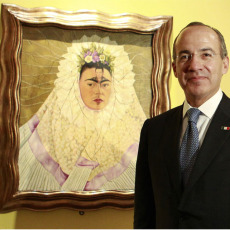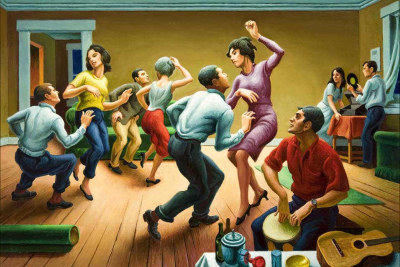OK, I’ll admit it, I was curious about Marina Abramovic’s The Artist Is Present at the Museum of Modern Art.* So, given the opportunity one day in late April, I went to sit with her myself. I was third in line, and had to wait only about 25 minutes, give or take. (You have heard about the man who has at least twice sat with her for an entire day, while dozens waited in line for their chance? I call that selfish.)
 Since I knew that I would not be able to sit long — work was pressing — I told a curatorial assistant there in the atrium that I hoped I wasn’t being impolite. She responded with an amusing and presumably accurate answer: “Marina doesn’t judge people,” she said.
Since I knew that I would not be able to sit long — work was pressing — I told a curatorial assistant there in the atrium that I hoped I wasn’t being impolite. She responded with an amusing and presumably accurate answer: “Marina doesn’t judge people,” she said.
I had no idea what the experience would be like, and it was surprisingly intense. In the course of daily life, most people don’t lock eyes, expressionless, for long periods of time. After a few minutes, I purposely softened my expression, largely because my blank stare seemed unnatural, but didn’t quite smile. I wasn’t thinking about much other than this was a new experience, that Abamovic looked (at this early hour) completely normal, if intent and practiced. I’m not sure others who sit with her think much more; MoMA’s “Visitor Viewpoint” webpage isn’t very revealing, and the Sitting With Marina group on Facebook has only 116 members and little commentary. I am mystified by another website showing that people end up in tears, sometimes after only four or five minutes. See: Marina Abramovic Made Me Cry.
Far too much, probably, has already been written about the show. Wouldn’t it be wonderful if most other museum exhibits got as much attention?
And here’s another “wouldn’t it be wonderful” from Colm Toibin’s blog for the New York Review of Books, who wrote about his 20-minute experience sitting with Marina.
…It made me feel that I could spend the day there opposite her, and maybe the next day too, and it also made me want to go, it made me consider at what point I would leave.
As soon as I began to think over my options, I forced myself to look at her more closely. I had no clear idea what she was thinking but she was doing a good imitation of someone gazing in the most serious way at someone else, like a painter might gaze in that second before applying the brush to the canvas, or like the sitter in turn might gaze at the painter. Or like we should look at paintings ourselves, or at things we believe in.
Photo: Courtesy the Museum of Modern Art
*A consulting client is a supporter of MoMA.

 The Webby Awards, which honor excellence on the web, were announced the other day, and with them comes a window on what the International Academy of Digital Arts and Sciences thinks of cultural websites — and what web denizens think, too, as each category has a People’s Choice award.
The Webby Awards, which honor excellence on the web, were announced the other day, and with them comes a window on what the International Academy of Digital Arts and Sciences thinks of cultural websites — and what web denizens think, too, as each category has a People’s Choice award.
 A strawberry today to Mexican President Felipe Calderon, who while on a state visit to Berlin this week stopped in at Martin Gropius Bau to see the Frida Kahlo retrospective. Yes, I know: photo op, tourist visit, etc. So, perhaps just a small strawberry.
A strawberry today to Mexican President Felipe Calderon, who while on a state visit to Berlin this week stopped in at Martin Gropius Bau to see the Frida Kahlo retrospective. Yes, I know: photo op, tourist visit, etc. So, perhaps just a small strawberry.
 On Friday, New York Gallery Week, which I’ve already written about
On Friday, New York Gallery Week, which I’ve already written about 
 Garrels didn’t blow Walsh off, but he didn’t provide a satisfying response either — he noted that many decisions on this had been made before he became curator and that SFMoMA’s collection is not a “comprehensive” one and therefore lacks work by women.
Garrels didn’t blow Walsh off, but he didn’t provide a satisfying response either — he noted that many decisions on this had been made before he became curator and that SFMoMA’s collection is not a “comprehensive” one and therefore lacks work by women.